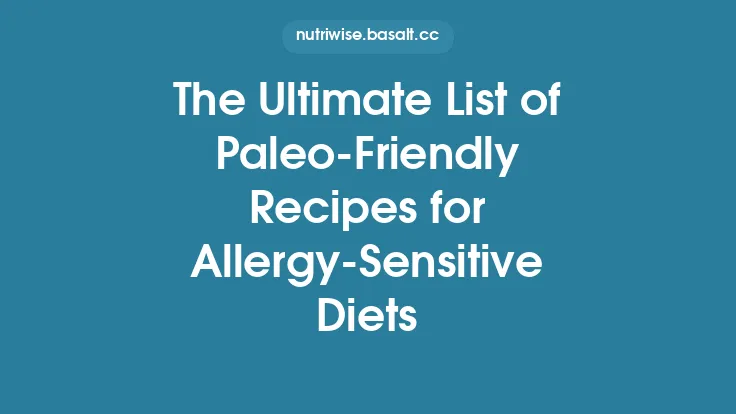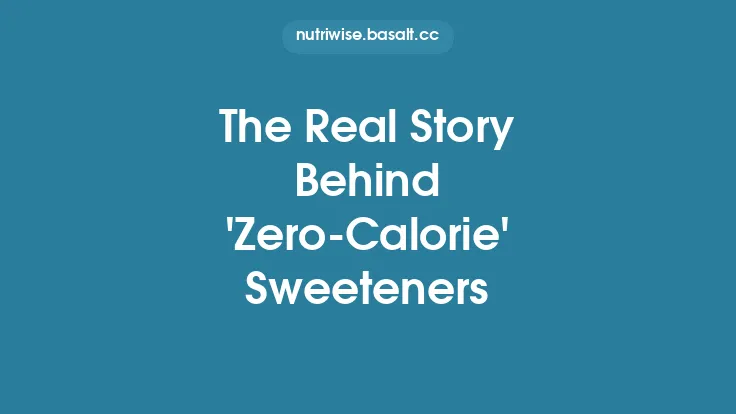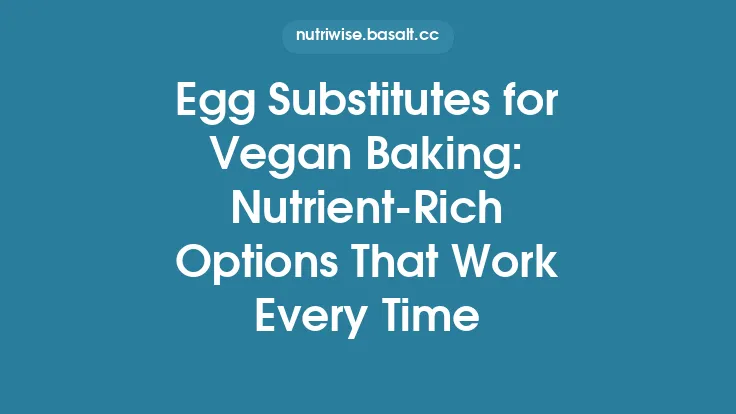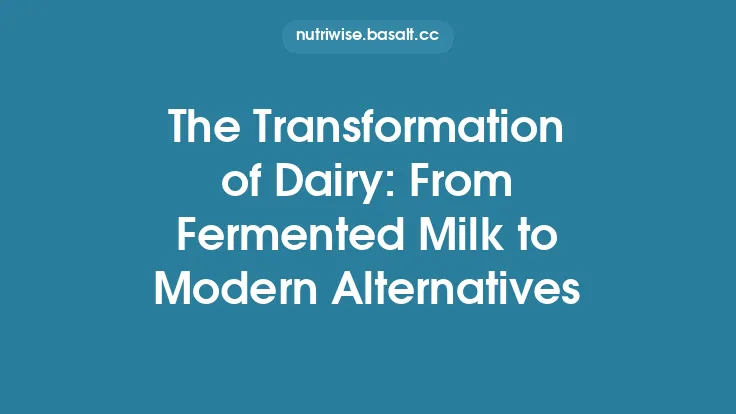When it comes to satisfying a sweet tooth, dairy often plays a starring role—think butter‑rich cookies, velvety custards, and creamy ice creams. For those who are lactose intolerant, allergic to dairy proteins, or simply following a dairy‑free lifestyle, the challenge is finding desserts that deliver the same indulgent mouthfeel and flavor depth without compromising on texture or taste. Fortunately, advances in food science and a growing pantry of plant‑based ingredients have made it possible to recreate classic dairy desserts that are virtually indistinguishable from their traditional counterparts. This guide walks you through the fundamentals of dairy‑free dessert creation, highlights the best ingredient swaps, and provides a toolbox of techniques that will empower you to craft luscious treats that truly taste like the real thing.
Understanding the Role of Dairy in Desserts
Fat, Protein, and Water Balance
Dairy contributes three primary functional components to desserts:
- Fat – Provides richness, mouth‑coating sensation, and helps trap air during whipping or creaming.
- Protein – Stabilizes emulsions (e.g., custards, ganache) and contributes to structure in baked goods.
- Water – Influences texture, steam generation, and the final crumb in cakes and pastries.
When removing dairy, you must replace each of these components in a way that mimics the same physical properties. A successful dairy‑free dessert balances these three pillars using plant‑based alternatives.
Flavor Profile Considerations
Milk and cream have subtle sweet‑cream notes and a slight umami from casein proteins. To replicate this, many dairy‑free recipes incorporate:
- Natural sweeteners (maple syrup, coconut sugar) that add caramel‑like depth.
- Flavor enhancers (vanilla, toasted nuts, a pinch of salt) that amplify the perception of richness.
- Fermented or cultured bases (coconut yogurt, soy kefir) that introduce mild tang reminiscent of cultured dairy.
Core Dairy‑Free Ingredients and Their Functions
| Ingredient | Primary Function | Typical Uses | Tips for Best Results |
|---|---|---|---|
| Coconut Cream | High fat (≈ 20‑25 g/100 ml) | Ice cream, mousse, ganache | Chill the can, scoop out the solidified layer, and whisk to a smooth consistency. |
| Silken Tofu | Protein & creaminess | Cheesecakes, puddings, frosting | Blend with sweetener and flavorings until ultra‑smooth; add a splash of neutral oil for extra silk. |
| Cashew Paste | Fat + subtle nutty flavor | Cream sauces, buttercream, caramel | Soak raw cashews 4‑6 h, then blend with water (1:1 ratio) for a velvety base. |
| Aquafaba (chickpea water) | Egg‑white‑like foaming agent | Meringues, macarons, mousse | Whip to stiff peaks; add cream of tartar (¼ tsp per ¼ cup) for stability. |
| Soy or Oat Milk | Liquid base, mild flavor | Custards, puddings, baked goods | Choose “barista” or “extra‑cream” versions for higher fat content. |
| Plant‑Based Butter (e.g., Earth Balance, Miyoko’s) | Solid fat for creaming | Cookies, pie crusts, frosting | Keep cold for optimal creaming; melt for sauces. |
| Nutritional Yeast | Umami, subtle cheesy note | Vegan “cheesecake” toppings, caramel sauces | Use sparingly; it can add a slightly bitter edge if overused. |
| Mango or Banana Puree | Natural sweetness & moisture | Frostings, ice cream bases | Balance with acid (lemon juice) to prevent overly sweet or gummy texture. |
Techniques for Replicating Classic Dairy Textures
1. Achieving a Creamy Custard Without Cream
A traditional custard relies on the coagulation of egg proteins in the presence of dairy fat. To mimic this:
- Base: Combine soy or oat milk with a tablespoon of coconut cream per cup of liquid for added richness.
- Thickener: Use a blend of cornstarch (1 tsp) and arrowroot powder (½ tsp) dissolved in a little cold milk, then whisk into the heated mixture.
- Stabilizer: Add a pinch of xanthan gum (≈ 0.1 % of total weight) to prevent graininess.
- Method: Heat gently, stirring constantly, until the mixture coats the back of a spoon (≈ 170 °F/77 °C). Remove from heat, then temper in beaten eggs for a traditional custard feel.
2. Whipping Coconut Cream to Stiff Peaks
- Chill the coconut cream and the mixing bowl for at least 30 minutes.
- Whisk with a handheld mixer on medium speed, gradually adding a sweetener (e.g., powdered erythritol) and a splash of vanilla.
- Stabilize with a pinch of cream of tartar or a teaspoon of powdered gelatin (if gelatin is tolerated) for longer‑lasting peaks.
3. Emulsifying a Dairy‑Free Ganache
- Heat equal parts dairy‑free chocolate (dark or milk‑style) and coconut cream until the chocolate is fully melted.
- Stir in a teaspoon of neutral oil (e.g., grapeseed) to improve gloss and fluidity.
- Cool to a spreadable consistency for truffles or a pourable state for drizzling.
4. Creating a “Butter” Consistency for Frostings
- Blend softened plant‑based butter with powdered sugar, a dash of almond extract, and a tablespoon of coconut cream.
- Adjust texture by adding more butter for firmness or more cream for a softer, spreadable frosting.
Signature Dairy‑Free Desserts That Taste Like the Real Thing
1. Classic Vanilla Bean Ice Cream (Coconut‑Based)
Key Points: High‑fat coconut cream, custard‑style thickening, vanilla bean seeds for authentic flavor.
Method Overview: Heat coconut cream, soy milk, and sugar; whisk in egg yolks tempered with the hot liquid; thicken with cornstarch; chill, then churn in an ice‑cream maker. Freeze for 4 hours before serving.
2. Rich Chocolate Mousse (Silken Tofu & Avocado)
Key Points: Silken tofu provides protein and body; ripe avocado adds buttery mouthfeel; dark chocolate supplies depth.
Method Overview: Melt dark chocolate, blend with tofu, avocado, maple syrup, and a pinch of sea salt until airy. Chill for at least 2 hours. Top with toasted cacao nibs.
3. Lemon “Cream” Tart (Cashew‑Based Filling)
Key Points: Soaked cashews create a smooth, tangy filling; lemon zest and juice deliver bright acidity.
Method Overview: Blend soaked cashews with lemon juice, zest, coconut oil, and agave syrup. Pour into a pre‑baked almond‑flour crust, bake at 350 °F for 15 minutes, then chill.
4. Peanut‑Butter Chocolate Chip Cookies (Plant‑Based Butter)
Key Points: Plant butter mimics the creaming stage; oat flour adds chew; dairy‑free chocolate chips melt like the real thing.
Method Overview: Cream plant butter with brown sugar, add peanut butter, then incorporate oat flour, baking soda, and chips. Bake 10‑12 minutes at 375 °F.
5. Caramel Sauce (Coconut Sugar & Coconut Cream)
Key Points: Coconut sugar caramelizes similarly to white sugar; coconut cream adds silk.
Method Overview: Melt coconut sugar with a splash of water, simmer until amber, whisk in coconut cream and a pinch of sea salt. Use warm over desserts or cool for a thick drizzle.
Allergy‑Friendly Adaptations and Substitutions
| Common Allergen | Substitute | How It Affects the Dessert |
|---|---|---|
| Nuts (cashews, almonds) | Sunflower seed butter, oat cream | Slightly less buttery flavor; add a dash of toasted sesame oil for depth. |
| Soy | Hemp milk, pea‑protein milk | May alter the protein content; increase thickener (e.g., arrowroot) to maintain custard set. |
| Gluten (in flour) | Rice flour, sorghum flour, almond flour | Adjust liquid ratios; gluten‑free flours often absorb more moisture. |
| Eggs (for meringues) | Aquafaba (chickpea water) | Whip to stiff peaks; add cream of tartar for stability. |
| Gelatin | Agar‑agar (1 tsp agar per 2 cups liquid) | Provides firm set for panna cotta‑style desserts; dissolve in boiling liquid. |
When catering to multiple sensitivities, keep a master ingredient list for each recipe, noting potential cross‑contamination sources (e.g., shared processing facilities). Labeling your finished desserts with a simple “Dairy‑Free, Nut‑Free” badge can help guests feel confident.
Storage, Shelf Life, and Food Safety
- Refrigerated Desserts (custards, mousse, cheesecake): Consume within 4‑5 days. Keep tightly sealed to prevent odor absorption.
- Frozen Desserts (ice cream, ice‑cream cakes): Store in airtight containers; best quality within 2‑3 months. Allow 10‑15 minutes at room temperature before scooping for optimal texture.
- Room‑Temperature Baked Goods (cookies, bars): Store in a cool, dry place in an airtight tin for up to 1 week. Adding a slice of bread to the container can maintain softness.
- Food Safety Note: Plant‑based milks can spoil faster than dairy. Always check for off‑flavors or separation before use, especially if the product has been opened for more than a week.
Troubleshooting Common Issues
| Problem | Likely Cause | Fix |
|---|---|---|
| Ice cream is grainy | Insufficient fat or over‑churning | Increase coconut cream ratio; churn at a slightly lower speed; add a small amount of alcohol (e.g., vodka) to lower freezing point. |
| Mousse collapses | Over‑whipping or insufficient stabilizer | Fold gently; incorporate a teaspoon of agar‑agar dissolved in hot water for extra hold. |
| Custard curdles | Temperature too high or rapid heating | Heat slowly over medium‑low heat; use a double boiler; remove from heat as soon as it coats the spoon. |
| Cookies spread too much | Too much liquid or insufficient fat | Chill dough for 30 minutes before baking; add a tablespoon of extra plant butter or reduce liquid by 10 %. |
| Ganache is too thick | Too much chocolate or not enough cream | Warm gently and whisk in a splash of neutral oil or extra coconut cream until desired consistency is reached. |
Building a Dairy‑Free Dessert Pantry
- Fats: Coconut cream, plant‑based butter, avocado oil, neutral oils (grapeseed, sunflower).
- Proteins: Silken tofu, soy or pea protein milk, almond or sunflower seed butter.
- Sweeteners: Maple syrup, coconut sugar, agave nectar, powdered erythritol (for frosting).
- Thickeners & Stabilizers: Cornstarch, arrowroot, tapioca starch, xanthan gum, agar‑agar, gelatin (if tolerated).
- Flavor Boosters: Pure vanilla extract, almond extract, citrus zest, toasted spices (cinnamon, cardamom).
- Chocolate & Cocoa: Dairy‑free dark chocolate (check for soy lecithin), cocoa powder, cacao nibs.
Keeping these staples on hand reduces the need for last‑minute trips to specialty stores and ensures you can whip up a dairy‑free dessert on a whim.
Final Thoughts
Creating desserts that taste like the real thing without dairy is less about “replacing” an ingredient and more about understanding the functional role each component plays. By mastering the balance of fat, protein, and water, and by leveraging the diverse toolbox of plant‑based alternatives, you can produce indulgent treats that satisfy cravings, respect dietary restrictions, and stand up to the classic versions in both flavor and texture. Whether you’re preparing a silky ice cream for a summer gathering, a rich chocolate mousse for a dinner party, or a quick batch of cookies for an after‑school snack, the techniques and ingredient insights outlined here will give you the confidence to bake, blend, and chill with dairy‑free flair—every time.





